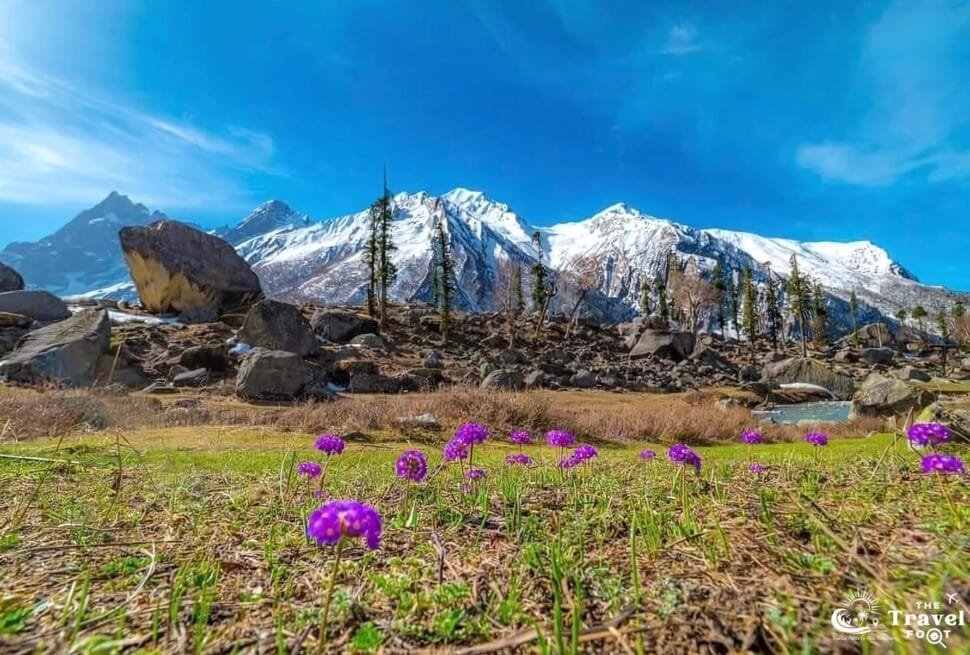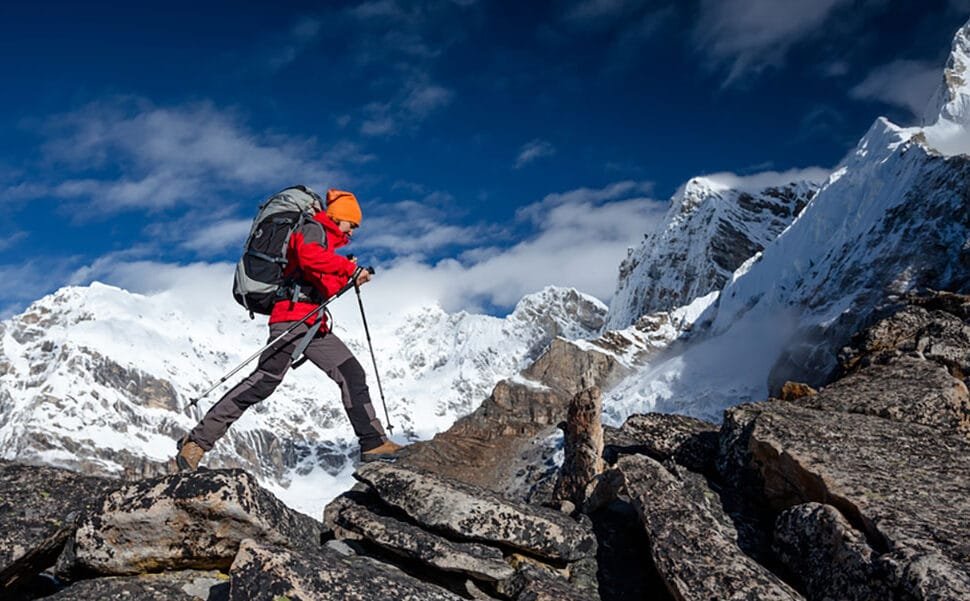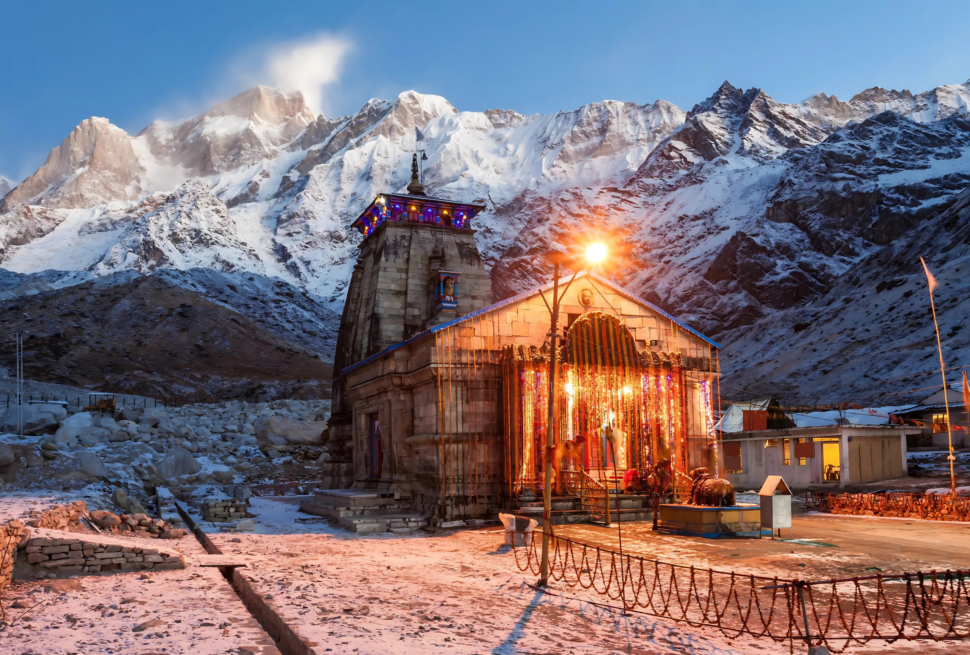Char Dham Yatra is a spiritually profound trip through the Himalayas, and the region’s unpredictability in weather can prove just as difficult as the terrain. In the yatra time (May through October), temperatures at the Char Dham shrines can vary and can be quite extreme. Experience temperatures that vary between 0°C to 15C, especially during the mornings, as well as late in the evenings. Even though it is summer, high elevations are prone to cold as well as sudden rainfalls, and even snow. The carefully curated list by The Travel Foot will ensure you’re well-equipped to be warm and cozy on your trip.
Clothings for Chardham Yatra :
Base & Inner Layers
- 3-4 Thermo outerwear set (top and bottom) Essential to wear in early mornings as well as evenings.
- 2 pair of wool leggings or base-layer pant for an additional layer of insulation to warm dhams
- 3-4 sets consisting of garments (preferably fast-drying and moisture-wicking)
- 2-3 pairs of warm leggings or tights (optional to women and great for layering beneath salwars and pants)
Mid Layers & Casual Wear
- 5 Comfortable and comfortable clothing Sets (cotton/synthetic mixtures to be worn on plains, and warmer layers for hilly terrain)
- 3 Full-sleeve T-shirts or tops that wick moisture Protect from the chill and sun
- 1-2 Kurtas / loose tunics (for modest temple wear)
Outerwear
- 2-3 Sweaters and fleece jackets light and cozy
- 1 Down jacket or heavy woollen required for Kedarnath as well as Yamunotri
- 1 Windcheater that is waterproof also known as raincoat and an hood. It is essential to be prepared to protect against abrupt mountain rains
- 1 Rainponcho (optional) It is easy to carry around and put on your bag for the day.
Bottom Wear
- 3-track pants or trekking trouser Comfortable elastic, stretchable and quick drying
- 1 pair of cozy wool pantalons (for cooler night or temple visit)
- 1-2 Traditional outfits (salwar kameez, dhoti/kurta) for temple rituals (optional but respectful)
Accessories for Warmth
- 1 Cap or beanie made of wool to be used ideal for early mornings or high-altitude places
- 1 Sun cap, or sun cap suitable for the midday sun in areas with open spaces
- 1 – 2 Scarves and mufflers or neck gaiters – all purpose such as sun, cold as well as dust and dirt protection
- 1 A stole or shawl can be used to cover the temples or add warmth
- 1 pair of woolen gloves to use ideal for mornings in the early hours or to take part in a Kedarnath temple visits
- 1 pair with cotton gloves (optional gloves are optional to protect yourself from sun or cold)
Socks & Footwear Liners
- 3-4 pairs cotton socks
- 3-4 pairs of woolen socks specially for colder and chilly nights.
- Ankle support sleeves or sock liner (optional for use to be used for treks that are long)
Nightwear
- 1 Set of comfortable clothing for nighttime (fleece or fully-sleeved pyjamas are suggested)
- Thermal night socks (optional – keeps feet warm overnight)
Pro Tip:
Dress in layers based the altitude and the time of the day. Mornings that are early at Kedarnath could feel like winter. During the afternoons, the lower hills may be pleasant. Keep a layer of warm clothing and rain cover inside your backpack for the day.
Footwear Essentials
1 pair of durable trekking or walking sneakers: It is recommended that shoes are waterproof and have ankle support, and soles that are non-slip. They are ideal for difficult tracks and paths that are uneven between Kedarnath as well as Yamunotri.
1 Light sandals, or floating shoes: Ideal for walking short distances for temple trips, short walks, or traveling days. Choose quick-dry material for wet conditions.
1 Slippers that are comfortable and comfort: For indoor use in hotel rooms, dharamshalas, or during breaks. It is easy to put on after a strenuous hike.
Pro Tip:
It’s important to get your trek footwear before the trek in order in order to avoid blisters, and also ensure the best satisfaction. Always keep an additional pair of dry socks on hand for treks, so you’re ready for whatever situation may arise.
Personal Care & Hygiene Essentials For Chardham Yatra
Stress the significance of taking care of your personal needs when you live in cold and remote areas. If you prioritize cleanliness, skin protection as well as convenience, you’ll be able to manage these harsh situations with ease.
Daily Hygiene
- Toothbrush & toothpaste (travel size)
- Tongue cleaner
- Facial wash (mild and hydrating)
- Body wash/soap (preferably an antibacterial size, suitable for travel)
- Shampoo and conditioner (travel packets or Sachets)
- Quick-drying towel (microfiber suggested)
Skincare & Protection
- Moisturizer/cold Cream (non-greasy to the dry mountain dry mountain air)
- Lip balm that contains SPF (must-have when you are at altitudes)
- Sunscreen (SPF 30+ or higher, broad-spectrum)
- Face wipes (alcohol-free, for refreshment on-the-go)
- Hand cream, or petroleum jelly (optional however useful)
- Aloe vera gel (for sunburn or skin irritation)
Hair Care
- Oil for hair (small bottle)
- Comb/hairbrush
- Clips, hair tie or bands
- Dry hair (optional to be used for longer periods of time without access to water)
Toiletries & Feminine Hygiene
- Napkins/tampons/menstrual cups (carry additional due to the limited supply)
- Toilet roll paper (at minimum 1-2 rolls, often not found in public restrooms)
- Wet wipes and dry tissues
- Urination disposable or reusable device designed for females (optional however useful in remote regions)
- Wash for hygiene in the intimate area (travel size, ad-hoc)
Grooming & Extras
- Nail cutter
- Mirror small (unbreakable recommended)
- Razor/shaving kit (if needed)
- Earbuds, cotton swabs
- Safety pins and a small sewing kit (in the event of mishaps with clothing)
- Deodorant/perfume (travel-size sprays or rolls-on)
- Strips of laundry detergent or Sachets (for washing clothes by hand)
Pro Tips:
- Select waterproof, container that is travel size for a better use of the space, and also avoid chaos.
- Utilize an bathroom bag in order to ensure that your toiletries are dry and organized.
- Pack items into ziplock bags for maintaining cleanliness and keep dry items separate from wet ones.
Medicines & First Aid Kit for Chardham Yatra
Security and health is a top priority when it comes to The importance of safety, health and security is paramount throughout the Char Dham Yatra, especially given the lack of medical services. A kit for personal use, with a complete first aid kit can save lives and give an assurance of safety.
Essential Personal Medications
- Medicines prescribed for regular use (with written dosage guidelines)
- The prescriptions’ copies (in cases of refills or emergency)
- Allergic reactions or medications for chronic conditions (asthma and diabetes BP and so on. )
Basic Over-the-Counter Medicines
- Paracetamol / Combiflam – for fever and general pain
- Cold and cough tablet (like Cetirizine, Benadryl, and D-Cold)
- Motion sickness tablets (Avomine, Domperidone)
- Antacids (Digene, Gelusil, Eno)
- Antidiarrheals (Loperamide or Norflox-TZ – only if prescribed)
- ORS / Electral sachets – for dehydration and electrolyte balance
Topical Applications
- Antiseptic liquid (Dettol/Savlon)
- Antiseptic cream (Betadine, Soframycin)
- Muscle relaxant spray or gel (Volini, Moov)
- Anti-itch cream/ Calamine lotion (for insect bites, rashes or other itchiness)
- Burn ointment (like Burnol – optional)
First Aid Supplies
- Sterile cotton & gauze pads
- Adhesive bandages (Band-Aids, assorted sizes)
- Crepe bandage (for sprains)
- Surgical tape/micropore
- Safety pins & scissors
- Tweezers (for getting rid of ticks, splinters and ticks. )
- Digital thermometer
- Disposable gloves (1-2 pairs)
Altitude & Cold-Related
- Diamox (Acetazolamide) – for altitude sickness
- Do not take this medication without consultation with your doctor
- Spray for nasal use (for nasal obstruction at higher altitudes)
- Lozenges for the throat / Strepsils (soothing for cold or dry air)
Insect & Environment Protection
- Mosquito repellent cream/spray (like Odomos or Good Knight)
- Vapour rub or inhaler (if you are prone to congested)
- Sunburn relief gel or lotion
Pro Tips:
- All medicines should be stored inside a water-proof zip bag or in a cases.
- Mark medicines with a clearly marked label if packaging for elderly or group usage.
- A small pouch filled with medications for emergencies inside you backpack for your day and keep it separate from the main bag.
Important Documents for Chardham Yatra
Be sure to carry the correct documents is crucial for smooth travel, verifying of checkpoints and hospital emergencies and accommodation throughout this Char Dham Yatra.
Identification & Registration
- Valid Government ID (Aadhaar card, Voter ID, Driving License, or Passport)
- Make sure to keep both the originals and copies of the original.
- Char Dham Yatra Registration Printout
- It is mandatory at all entry locations. Make sure to keep a copy of the soft copy of the form on your smartphone.
- Health Fitness Certificate (if necessary, especially in relation to Kedarnath trek) Kedarnath Trek)
Travel & Stay Documents
- Printed Hotel Booking Confirmations
- It can be helpful for situations when network issues hinder email/SMS accessibility.
- Train / Bus / Flight Tickets (Hard & Soft Copies)
- Yatra ePass / Helicopter Tickets (if booked)
Photos & Backups
- 3-4 Passport-size Photographs
- is required for registrations, permits, or for emergency identifications.
- Photocopies of All Key Documents
- Maintain two sets of them in separate places in your bag, and also with a co-traveler (if you have any).
Digital Backup Tips
- Find all the important documents, scan them and save them
- In your phone’s gallery
- In cloud storage (Google Drive, Dropbox, etc. )
- On a USB drive (optional)
Electronics & Accessories
- Mobile phone that comes with charger
- It is recommended to use an prepaid SIM (like BSNL or Jio) to have greater connectivity in the mountains
- Energy banks (10,000 mAh or greater) – an essential item for those who travel long days or power failures
- Headlamp or torch (with additional batteries)
- is essential for temple visits in the early morning and other areas without street lights
- Universal extension cord/adapter to allow sharing charging in hotels and dharamshalas
- Earphones and headphones are great for meditation, music or even calls at a moment’s notice
- Camera (optional) is a great option if you’re looking to take high-quality pictures
- Extra memory cards and cameras batteries Storage could be restricted in remote locations.
Energy Bars & Snacks
- Dry fruit and nuts trail mix – – energy-rich and not-perishable
- Protein bars/energy bar are compact and perfect for long hikes
- Instant food (cup noodles, soup sachets, poha, upma) – add hot water
- Biscuits as well as glucose and salty snack foods fast energy boost
- Candy/sweets/toffees cubes are useful for nausea, or when you are low on energy
- Reusable thermos or water bottle to keep well-hydrated while on the move
- Electrolyte / ORS packets are essential to avoid fatigue and dehydration.
Miscellaneous Essentials
- Daypack/small bag used for everyday necessities during hikes as well as temple trips
- Lockable suitcase or trekking rucksack – depending on travel style
- Umbrella or poncho – for sudden mountain rains
- Sunglasses (UV-protected) – protect your eyes at high altitudes
- Walking stick/trekking pole – helpful on steep or uneven terrain
- Small book of prayers (also known as japa mala) to be used for individual devotion to the temples
- Polybags / dry bags – for wet clothes or organizing items
- Safety pins needles and needle kit to help with fast clothing repairs
- A neck or travel pillows is ideal for longer journeys or for better sleep
Essential Travel Tips for Char Dham Yatra
Be protected, courteous and well-prepared throughout your travels.
- Pack Smart & Light: Take only the essentials. Pick versatile, multi-layered clothes and small gear for easy movement during temple trips.
- Go Plastic-Free: Uttarakhand completely restricts the use of single-use plastics. Carry baggies, bottles and other containers that are recyclable and other eco-friendly options in order to reduce environmental impacts.
- Carry Cash: ATMs are a bit scarce and in remote locations, they are not reliable. Make small amounts of cash for purchases in the local area or tips as well as donation to entry points.
- Acclimatize to Altitude: The high altitude can impact the quality of your breath and levels of energy. Keep your pace, stay away from overtraining as well as hydrate yourself with ORS and warm liquids.
- Follow Temple Etiquette: Dress modestly and in conventional attire to enter temples. Dress your legs and shoulders in a modest manner as well as avoid extravagant or tight-fitting clothing to show respect.




